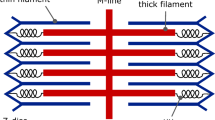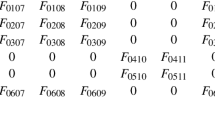Abstract
Intima formation in vessels, spontaneous or experimentally induced, is generally characterized by the presence of longitudinally orientated smooth muscle cells (LSMC). During an experiment of neo-intima induction in carotid arteries in rabbits, by application of a nonconstrictive silastic cuff, a study was performed to investigate the presence of LSMC in the systemic and pulmonary circulations, in both elastic and muscular arteries. Three patterns could be distinguished: intimai cushions in muscular arteries, single or small groups of LSMC in the intima in elastic and larger muscular arteries, and intra-medially located layers or columns of LSMC in the aorta, the pulmonary artery, at the bifurcation of the aorta and around orifices of branches. In order to understand this peculiar orientation a biomechanical approach was used: this showed that near the lumen the circumferential stress is 4.5 times higher than the longitudinal. Because the cell surface of the smooth muscle cells exposed to this stress per unit vessel length is much less in the longitudinal than in the circular direction we conclude that the LSMC align in the direction which allows them to cope most effectively with the mechanical stresses.
Similar content being viewed by others
References
Benninghoff A (1930) Die Arterien. In: Von Möllendorf H (ed) Handbuch der Mikroskopischen Anatomie des Menschen, vol 6, part 1, Springer, Berlin Heidelberg New York, pp 49–131
Betz E, Schlote W (1979) Responses of vessel walls to chronically applied electrical stimuli. Basic Res Cardiol 74:10–20
Booth RFG, Martin JF, Honey AC, Hassal DG, Beesly JE, Moncada S (1989) Rapid development of atherosclerotic lesions in the rabbit carotid artery induced by perivascular manipulation. Atherosclerosis 76:257–268
Buck RC (1963) Histogenesis and morphology of arterial tissue. In: Sandier M, Bourne GH (eds) Atherosclerosis and its origin, Academic Press, New York, p 24
Buck RC (1979) Contact guidance in the subendothelial space. Repair of rat aorta in vitro. Exp Mol Pathol 31:275–283
Buck RC (1983) Behaviour of vascular smooth muscle cells during repeated stretching of the substratum in vitro. Atherosclerosis 46:217–223
Chuong CJ, Fung YC (1983) Three-dimensional stress distribution in arteries. J Biomech Eng 105:268–274
Chuong CJ, Fung YC (1986) On residual stresses in arteries. J. Biomech Eng 108:189–192
Dartsch PC, Hämmerle H (1986) Orientation response of arterial smooth muscle cells to mechanical stimulation. Eur J Cell Biol 41:334–346
Fung YC, Fronek K, Patitucci P (1979) Pseudoelasticity of arteries and the choice ot its mathematical expression. Am J Physiol 237:H620-H631
Gebrane J, Roland J, Orcel L (1982) Experimental diffuse intimai thickening of the femoral arteries in the rabbit. Virchows Arch [A] 396:41–59
Hassler D (1961) Physiological intima cushions in the large cerebral arteries of young individuals. Acta Pathol Microbiol Scand 55:19–34
Jores L (1924) Arterien. In: Henke F, Lubarsch O (eds) Handbuch der Speziellen Pathologischen Anatomie und Histologie, vol 2, Springer, Berlin Heidelberg New York, pp 680–732
Kockx MM, De Meyer GR, Jacob WA, Bult H, Herman AG (1992) Triphasic sequence of neo-intimal formation in the cuffed carotid artery of the rabbit. Arteriosclerosis Thrombosis 12:1447–1457
Langer F (1924) Studien zur Pathologie der Arterien, insbesondere zur Lehre von der Arteriosklerose. Virchows Arch 248:453–604
Langes K, Horst W (1992) Intimal fibrosis (phlebosclerosis) in the saphenous vein of the lower limb: a quantitative analysis. Virchows Arch [A] 421:127–131
Lopes de Faria J (1961) Observations on the structure of the coronary arteries of rabbits of variable age. Acta Anat 46:230–243
Meyer WW, Walsh SZ, Lind J (1980) Functional morphology of human arteries during foetal and postnatal development. In: Schwartz CJ, Werthessen NT, Wolf S (eds) Structure and function of the circulation, vol I, Plenum Press, New York, pp 99–379
Milroy CM, Scott DJA, Beard JD, Horrocks M, Bradfield JWB (1989) Histological appearances of the long saphenous vein. J Pathol 159:311–316
Prescott MF, McBride KC, Court M (1989) Development of intimai lesions after leucocyte migration into the vascular wall. Am J Pathol 135:835–846
Reidy MA (1985) A reassessment of endothelial injury and arterial lesion formation. Lab Invest 53:513–520
Rhodin JA (1980) Architecture of the vessel wall. In: Bohr DF, Somlyo AP, Sparks HV Jr (eds). Handbook of physiology, section 2. The cardio-vascular system, vol II. Vascular smooth muscle, American Physiological Society, Bethesda, pp 1–32
Silver FH, Christiansen DL, Buntin CM (1989) Mechanical properties of the aorta: a review. Crit Rev Biomed Eng 17:323–3598
Stary HC, Blankenhorn DH, Chandler AB, Glagow S, Insull W Jr, Richardson M, Rosenfeld ME, Schaffer SA, Schwartz CJ, Wagner WD, Wissler RW (1992) A definition of the intima of human arteries and of its atherosclerosis-prone lesions. Arteriosclerosis Thrombosis 12:120–134
Thoma R (1920) Über die Strömung des Blutes in der Gefäßbahn und die Spannung. Beitr Pathol Anat 66:91–158, 259–329
Wagenaar SJ Sc, Wagenvoort CA (1978) Experimental production of longitudinal smooth muscle cells in the intima of muscular arteries. Lab Invest 39:370–374
Weibel ER (1958) Die Entstehung der Längsmuskulatur in den Ästen der A-Bronchiales. Z Zellforsch 47:440–468
Author information
Authors and Affiliations
Rights and permissions
About this article
Cite this article
Kockx, M.M., Wuyts, F.L., Buyssens, N. et al. Longitudinally orientated smooth muscle cells in rabbit arteries. Vichows Archiv A Pathol Anat 422, 293–299 (1993). https://doi.org/10.1007/BF01608338
Received:
Revised:
Accepted:
Issue Date:
DOI: https://doi.org/10.1007/BF01608338




